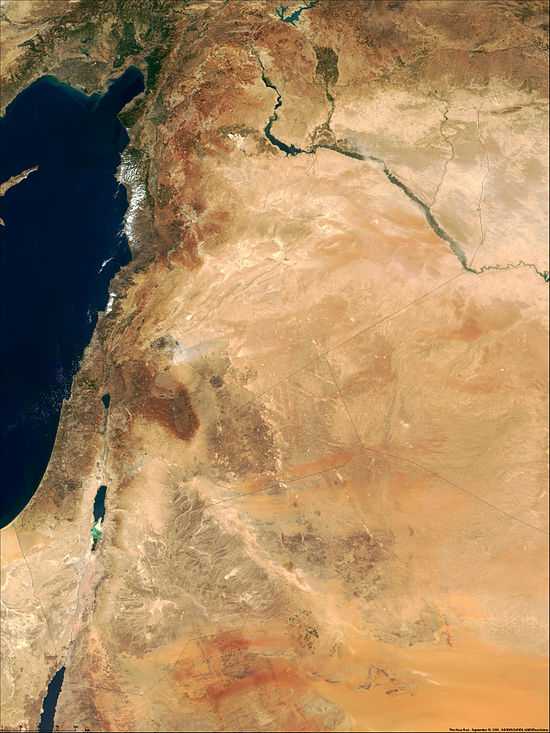Coele-Syria
| Coele-Syria | |||||
| Region of Macedonian Empire / Ptolemaic Kingdom / Seleucid Kingdom | |||||
| |||||
| Historical era | Hellenistic era | ||||
| - | Conquests of Alexander the Great | 332 BC | |||
| - | Hasmonean Revolt, Conquests of Pompey | 64 BC | |||
Coele-Syria (Ancient Greek: Κοίλη Συρία), or Cœle-Syria, Koile Syria or Celesyria, was a Hellenistic term for a region of Syria. It is widely accepted that the term Coele is a transcription of Aramaic kul, meaning "all, the entire", such that the term originally identified all of Syria.[1][2][3] The word "Coele", which literally means "hollow" in Koine Greek, is thought to have come about via a folk etymology referring to the "hollow" Beqaa Valley between Mount Lebanon and the Anti-Lebanon mountains.[3]
The term was commonly used in this wider sense to indicate "all Syria" or "all Syria except Phoenicia", by writers including Diodorus Siculus, who indicated Coele-Syria to stretch as far south as Joppa, as well as Polybius, Pliny, Arrian and Ptolemy.[4]
The first and only official use of the term was during the period of Seleucid rule of the region, between c. 200 BC and 64 BC.
During this period, the term "Coele Syria and Phoenicia" or "Coele Syria" was also used in a narrower sense to refer the former Ptolemaic territory which the Seleucids controlled, being the area south of the river Eleutherus. This usage was adopted by Strabo and the Books of the Maccabees. However, Eunapius wrote that the capital of Coele-Syria was the Seleucid city of Antioch, which is North of the Eleutherus.[5] In addition, other Greek writers used the term Palestine to refer to the region during this period, such as Polemon of Athens and Pausanias.[6][7][8]
First known official usage
According to Polybius, a former officer of the Ptolemaic Empire named Ptolemy Thrasea, having fought in the 217 BC Battle of Raphia, defected to the Seleucid king Antiochus III the Great. Antiochus gave him the title "Strategos and Archiereus of Coele-Syria and Phoenicia". Some scholars speculate that this title may have been used previously by the Ptolemies, but no direct evidence exists to support this.[3]
Syrian Wars

The region was disputed between the Seleucid dynasty and the Ptolemaic dynasty during the Syrian Wars. Alexander the Great's general Ptolemy first occupied Coele-Syria in 318 BC. However, when Ptolemy joined the coalition against Antigonus I Monophthalmus in 313 BC, he quickly withdrew from Coele-Syria. In 312 BC Seleucus I Nicator, defeated Demetrius, the son of Antigonus, in the Battle of Gaza which again allowed Ptolemy to occupy Coele-Syria. Though he was again to pull out after only a few months, after Demetrius had won a battle over his general and Antigonus entered Syria in force up to Antigonuses, this brief success had enabled Seleucus to make a dash for Babylonia which Seleucus secured. In 302 BC, Ptolemy joined a new coalition against Antigonus and reoccupied Coele-Syria, but quickly withdrew on hearing a false report that Antigonus had won a victory. He was only to return when Antigonus had been defeated at Ipsus in 301 BC. Coele-Syria was assigned to Seleucus, by the victors of Ipsus, as Ptolemy had added nothing to the victory. Though, given Ptolemy's track record, he was unlikely to organize a serious defense of Coele-Syria, Seleucus acquiesced in Ptolemy's occupation, probably because Seleucus remembered how it had been with Ptolemy's help he had reestablished himself in Babylonia.
The later Seleucids were not to be so understanding, resulting in the century of Syrian Wars between the Ptolemies and Seleucids. The Battle of Panium in 200 BC, during the Fifth Syrian War, was the final decisive battle between the two sides in ending Ptolemaic control over the region. The 171–168 BC conflicts over Coele-Syria, between Antiochus IV Epiphanes and Ptolemy VI Philometor, are discussed in Livy’s The History of Rome from its Foundation (in XLII. 29 and XLV. 11–12).
Seleucid control over the area of Judea began diminishing with the eruption of the Maccabean Revolt in 165 BC. With Seleucid troops being involved in warfare on the Parthian front, Judea succeeded in securing its independence by 140 BC. Despite attempts of Seleucid rulers to regain territories, the conquests of Pompey in 64 BC were a decisive blow to them, and Syria became part of the Roman Republic.
See also
- Hasmonean kingdom
- Roman Syria
- Herodian kingdom
- Tetrarchy (Judea)
- Judaea (Roman province)
- Syria Palaestina
Notes
- ↑ , "La Syrie creuse n'existe pas", in G. L. Gatier, et al. Géographie historique au proche-orient (1988:15-40), reviving the explanation offered by A. Schalit (1954), is reported by Robin Lane Fox, Travelling Heroes in the Epic Age of Homer (2008, notes p378f): "the crux is solved".
- ↑ The Hellenistic Settlements in Syria, the Red Sea Basin, and North Africa, Getzel M. Cohen, 2006 and pdf here
- ↑ 3.0 3.1 3.2 A History of the Jews and Judaism in the Second Temple Period, Volume 2, Lester L. Grabbe, p173 "Yet the suggestion is widely accepted that the name actually derives from Aramaic for "all Syria", which was then assimilated by the Greeks to a more usual pattern for place names"
- ↑ From Sartre, pages 21-25: Diodorus 18.6.3, 61.4; 20.73.2; Polybius 8.17.10–11; Pliny, Naturalis Historiæ 5.106–10; Arrian Anabasis 2.13.7; Ptolemy 5.14.1.
- ↑ Eunapius, Lives of the Philosophers and Sophists
- ↑ Studies in Josephus and the varieties of ancient Judaism: Louis H. Feldman. Books.google.co.uk. Retrieved 2011-12-11.
- ↑ "Pausanias, Description of Greece, 9. 1 - 22". Theoi.com. Retrieved 2011-12-11.
- ↑ Parke, Herbert William. Sibyls and sibylline prophecy in classical antiquity. Books.google.co.uk. Retrieved 2012-05-28.
External links
- Bagnall, R., J. Drinkwater, A. Esmonde-Cleary, W. Harris, R. Knapp, S. Mitchell, S. Parker, C. Wells, J. Wilkes, R. Talbert, M. E. Downs, M. Joann McDaniel, B. Z. Lund, T. Elliott, S. Gillies. "Places: 991407 (Syria Coele)". Pleiades. Retrieved March 8, 2012.